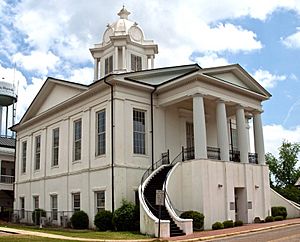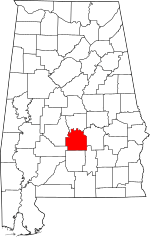Lowndes County, Alabama facts for kids
Quick facts for kids
Lowndes County
|
||
|---|---|---|

Lowndes County Courthouse in Hayneville
|
||
|
||

Location within the U.S. state of Alabama
|
||
 Alabama's location within the U.S. |
||
| Country | ||
| State | ||
| Founded | January 20, 1830 | |
| Named for | William Jones Lowndes | |
| Seat | Hayneville | |
| Largest town | Fort Deposit | |
| Area | ||
| • Total | 725 sq mi (1,880 km2) | |
| • Land | 716 sq mi (1,850 km2) | |
| • Water | 9.2 sq mi (24 km2) 1.3% | |
| Population
(2020)
|
||
| • Total | 10,311 | |
| • Estimate
(2023)
|
9,717 |
|
| • Density | 14.222/sq mi (5.491/km2) | |
| Time zone | UTC−6 (Central) | |
| • Summer (DST) | UTC−5 (CDT) | |
| Congressional district | 7th | |
|
||
Lowndes County is located in the central part of Alabama, a state in the United States. According to the 2020 census, about 10,311 people live in the county. Its main town, or county seat, is Hayneville. The county is named after William Lowndes, a well-known person from South Carolina who served in the United States Congress.
Lowndes County is part of the Montgomery, Alabama area. It is also known for being in the "Black Belt" region. This area has very rich soil, which was once used for large cotton farms. Many African American workers, first enslaved and later free, lived and worked here.
Contents
History of Lowndes County
Lowndes County was officially formed on January 20, 1830. It was created from parts of Montgomery, Dallas, and Butler counties. The county is named after William Lowndes, a statesman from South Carolina. It is part of the Black Belt, where large cotton farms grew during the years before the American Civil War. Farming remained a very important part of the economy here for a long time.
After the Civil War, during a time called Reconstruction, African Americans were elected to local and state government jobs. However, white leaders in the state regained power by 1874. They passed new state laws in 1875 and 1901 that made it very hard for most African Americans and many poor white people to vote. For example, people had to pay a special tax called a poll tax to register to vote. They also had to pass literacy tests, which were often very difficult. These rules greatly reduced the number of African American voters.
From the late 1800s to the early 1900s, there was a lot of violence against African Americans in the county. This was part of an effort to maintain white control. Sadly, 16 lynchings were recorded in Lowndes County during this time. Most of the victims were African American men. In 1900, a mob killed a black man. When Jim Cross, a local black resident, spoke up, he was killed, along with his wife, son, and daughter. In 1917, two black brothers were killed for supposedly being disrespectful to a white farmer. On July 31, 2016, a special marker was put up in Letohatchee to remember these terrible events.
Over time, the way people farmed changed, and many African Americans moved away from the South in what was called the Great Migration. This caused the county's population to drop a lot. New farming machines and a bug called the boll weevil also hurt cotton crops in the 1920s and 1930s. This meant fewer jobs on farms.
Civil Rights Era
By 1960, the population of Lowndes County had fallen to about 15,000 people. About 80 percent of the residents were African American. The county was sometimes called "Bloody Lowndes" because of the violence used to keep racial segregation in place. Even a century after the Civil War, and decades after African Americans lost their right to vote, white leaders used fear and violence to stop them from voting.
Even though the population had dropped, African Americans still outnumbered white residents by about 4 to 1. However, a small number of white families owned most of the land and controlled the local government. Most African Americans worked in low-paying farm jobs. Before March 1, 1965, not a single African American person was registered to vote in Lowndes County.
When the Civil Rights Act of 1964 and the Voting Rights Act of 1965 were passed, civil rights leaders saw a chance to fight for change in Lowndes. The Lowndes County Freedom Organization (LCFO) was started in the county. It was a new political party created to help African Americans stand up for their rights.
A young civil rights leader named Stokely Carmichael from the Student Nonviolent Coordinating Committee (SNCC) helped organize the LCFO. In the summer of 1965, they worked hard to register African Americans in the county to vote. Their goal was simple: get enough African Americans to vote so they could have a voice in their local government. This would help direct services to African American residents, as most of them lived in poverty. Carmichael and others held voter registration drives, protests, and classes to teach people about politics. The Voting Rights Act allowed the federal government to watch over voting in places like Lowndes County, where minority groups had been kept from voting.
Police continued to arrest protesters in 1965. On August 20, 1965, a group of protesters were released from jail in Hayneville. As four of them walked toward a store, a special deputy named Thomas Coleman told them to leave. When he aimed his shotgun at a young African American woman named Ruby Sales, Jonathan Myrick Daniels pushed her out of the way. Daniels, an Episcopal seminarian, was shot and killed instantly. Coleman also shot Father Richard Morrisroe, a Catholic priest, in the back. Coleman was later tried for Daniels' murder, but an all-white jury quickly found him not guilty. Coleman claimed he acted in self-defense, even though both men were unarmed.
In 1966, after helping African Americans register to vote, the Lowndes County Freedom Organization (LCFO) put forward several local residents as candidates for county jobs. This was the first independent black political party in the county since Reconstruction. The LCFO chose the black panther as its symbol, while the white-led Alabama Democratic Party used a white rooster. On May 3, 1966, over 900 registered African American voters cast their ballots in Hayneville. Some drove more than 25 miles to vote. The LCFO encouraged black voters to help each other if needed. They also told voters to simply "pull the lever for the Black Panther" to vote for all LCFO candidates.
White people in Lowndes County strongly opposed the LCFO. White landowners evicted many African American sharecroppers from their homes and land because they were involved in civil rights work. This left families homeless and without jobs. SNCC and LCFO leaders helped these families stay together. They bought tents, beds, heaters, food, and water, and helped several families build a temporary "tent city." Even with harassment, like shots being fired into the camp, these residents stayed strong for almost two years. Organizers helped them find new jobs and permanent homes.
White businesses refused to serve known LCFO members. Several small fights broke out over this issue. The LCFO kept organizing and registering voters. However, none of their candidates won in the November 1966 election. Some historians believe that African American sharecroppers were afraid to vote because of the strong pressure from white plantation owners, who employed most of them. After the LCFO joined the statewide Democratic Party in 1970, African Americans began to win local elections. Today, most white conservative voters in Alabama have joined the Republican Party.
In a court case called White v. Crook (1966), a judge named Frank M. Johnson ruled that African Americans in Lowndes County had been unfairly kept off juries. Women of all races were also excluded from juries by state law. Judge Johnson ordered Alabama to include both African American men and women, as well as other women, on juries. This was based on their rights under the Fourteenth Amendment. This case was one of the first legal actions to fix the problem of African Americans being systematically kept off juries.
The LCFO continued to work for more people to be involved in politics. Their idea of community control over politics spread to the wider civil rights movement. In 1970, John Hullett became the first African American sheriff elected in the county since Reconstruction.
Today, a special center in the county, run by the National Park Service, remembers the Tent City and the LCFO's efforts to organize politically.
Geography
Lowndes County covers about 725 square miles. Of this, 716 square miles is land, and 9.2 square miles (about 1.3%) is water. The county is located in the Gulf Coastal Plain region of Alabama.
Major Roads
 Interstate 65
Interstate 65 U.S. Highway 31
U.S. Highway 31 U.S. Highway 80
U.S. Highway 80 State Route 21
State Route 21 State Route 97
State Route 97 State Route 185
State Route 185 State Route 263
State Route 263
Neighboring Counties
- Autauga County (north)
- Montgomery County (east)
- Crenshaw County (southeast)
- Butler County (south)
- Wilcox County (southwest)
- Dallas County (west)
Protected Areas
- Selma to Montgomery National Historic Trail (part of it is in Lowndes County)
Population Information
| Historical population | |||
|---|---|---|---|
| Census | Pop. | %± | |
| 1830 | 9,410 | — | |
| 1840 | 19,539 | 107.6% | |
| 1850 | 21,915 | 12.2% | |
| 1860 | 27,716 | 26.5% | |
| 1870 | 25,719 | −7.2% | |
| 1880 | 31,176 | 21.2% | |
| 1890 | 31,550 | 1.2% | |
| 1900 | 35,651 | 13.0% | |
| 1910 | 31,894 | −10.5% | |
| 1920 | 25,406 | −20.3% | |
| 1930 | 22,878 | −10.0% | |
| 1940 | 22,661 | −0.9% | |
| 1950 | 18,018 | −20.5% | |
| 1960 | 15,417 | −14.4% | |
| 1970 | 12,897 | −16.3% | |
| 1980 | 13,253 | 2.8% | |
| 1990 | 12,658 | −4.5% | |
| 2000 | 13,473 | 6.4% | |
| 2010 | 11,299 | −16.1% | |
| 2020 | 10,311 | −8.7% | |
| 2023 (est.) | 9,717 | −14.0% | |
| U.S. Decennial Census 1790–1960 1900–1990 1990–2000 2010–2020 |
|||
As of the 2020 United States census, there were 10,311 people living in Lowndes County. There were 4,251 households and 2,741 families.
In 2020, the population was made up of different groups:
- About 27.22% were White (not Hispanic or Latino).
- About 69.33% were Black or African American (not Hispanic or Latino).
- Other groups like Native American, Asian, and people of two or more races made up smaller percentages.
- About 1.36% of the population was Hispanic or Latino (of any race).
Education
Students in Lowndes County attend schools run by Lowndes County Public Schools. These schools include:
- Calhoun High School
- Central Elementary School
- Central High School
- Fort Deposit Elementary School
- Hayneville Middle School
- Jackson-Steele Elementary School
- Lowndes County Middle School
Communities
Towns
- Benton
- Fort Deposit
- Gordonville
- Hayneville (the county seat)
- Lowndesboro
- Mosses
- White Hall
Other Communities
- Braggs
- Burkville
- Calhoun
- Collirene
- Letohatchee
- Mount Willing
- Sandy Ridge
- Trickem
Images for kids
See also
 In Spanish: Condado de Lowndes (Alabama) para niños
In Spanish: Condado de Lowndes (Alabama) para niños




